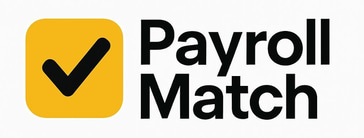The Pros and Cons of Earned Wage Access: What HR Professionals Need to Know
Navigating the ever-evolving landscape of payroll solutions can be challenging, but Earned Wage Access (EWA) is emerging as a game-changer for both employers and employees. EWA allows employees to access a portion of their earned wages before their regular payday, and it's gaining traction as a tool to enhance employee financial wellness. As businesses strive to offer more competitive benefits, integrating EWA can be a strategic move to boost employee retention and satisfaction. But what does this mean for HR professionals and small business owners looking to adopt such a system? Join us as we delve into the pros and cons of EWA, exploring why it might just be the financial flexibility your company needs.
Payroll Match
5/31/20254 min read


Benefits of Earned Wage Access
Earned Wage Access (EWA) offers several advantages for both employers and employees. Let's explore the key benefits that make EWA an attractive option for businesses looking to enhance their payroll solutions.
Improved Employee Financial Wellness
EWA can significantly boost employee financial health by providing a safety net for unexpected expenses. By allowing workers to access their earned wages before payday, EWA reduces reliance on high-interest payday loans or credit card debt.
This financial flexibility can lead to reduced stress and improved focus at work. Employees who aren't constantly worried about making ends meet are more likely to be productive and engaged.
Studies have shown that EWA users are better able to handle financial emergencies and avoid late fees on bills, contributing to overall financial stability.
Increased Employee Retention and Satisfaction
Offering EWA can be a powerful tool for boosting employee satisfaction and loyalty. When workers feel their employer cares about their financial well-being, they're more likely to stay with the company long-term.
This increased retention can lead to significant cost savings for businesses. The expenses associated with recruiting, hiring, and training new employees often far outweigh the costs of implementing an EWA program.
Moreover, satisfied employees tend to be more productive and provide better customer service, creating a positive ripple effect throughout the organization.
Competitive Advantage in Hiring
In today's tight labor market, offering EWA can give your company a significant edge in attracting top talent. Many job seekers, especially younger workers, are looking for employers who provide innovative benefits that support their financial health.
By highlighting EWA as part of your benefits package, you can differentiate your company from competitors who only offer traditional payroll options. This can be particularly effective in industries with high turnover rates or those competing for in-demand skills.
According to recent surveys, a majority of workers say they would be more interested in working for an employer that offers EWA, making it a powerful recruitment tool.
Potential Pitfalls of Offering EWA
While Earned Wage Access can provide numerous benefits, it's important to be aware of potential challenges. Understanding these pitfalls can help you implement EWA more effectively and avoid common issues.
Payroll Complexity
Implementing EWA can introduce new complexities to your payroll process. Managing frequent wage disbursements outside of regular pay periods requires careful tracking and reconciliation.
There's a risk of increased administrative burden, especially for smaller businesses with limited HR resources. Ensuring accurate tax withholdings and compliance with labor laws becomes more challenging with multiple wage access points.
To mitigate these risks, it's crucial to choose an EWA solution that integrates seamlessly with your existing payroll system and provides robust reporting features.
Cash Flow Management Issues
EWA can potentially impact your company's cash flow, particularly if a large portion of your workforce opts to access their wages early. This can be especially challenging for small businesses or those with tight operating margins.
It's important to carefully model the potential impact on your cash flow before implementing EWA. Consider setting limits on how much and how often employees can access their wages to maintain financial stability.
Working closely with your finance team or advisor can help you strike the right balance between offering financial flexibility to employees and maintaining healthy cash flow for the business.
Employee Dependency
While EWA can provide valuable financial support, there's a risk that some employees may become overly reliant on accessing their wages early. This dependency could potentially lead to a cycle of financial stress if not managed properly.
To address this concern, it's important to couple EWA with financial education programs. Helping employees understand budgeting, saving, and responsible use of EWA can prevent overreliance on the service.
Consider implementing a system that gradually reduces the frequency of early wage access for frequent users, encouraging them to build more sustainable financial habits over time.
Best Practices for Implementing EWA
To maximize the benefits of Earned Wage Access while minimizing potential drawbacks, it's crucial to follow best practices during implementation. Here are some key strategies to ensure a successful EWA rollout.
Clearly Define Policies and Limitations
Establishing clear guidelines for your EWA program is essential for smooth operation and employee understanding. Start by defining specific limits on how often and how much employees can access their earned wages.
Communicate these policies clearly to all employees, ensuring they understand both the benefits and the limitations of the program. Consider creating a comprehensive FAQ document to address common questions and concerns.
Regular review and adjustment of these policies based on usage data and employee feedback can help optimize the program over time.
Choose the Right EWA Vendor
Selecting the right EWA provider is crucial for the success of your program. Look for vendors with a strong track record of reliability, compliance, and customer support.
Key factors to consider include:
Ease of integration with your existing payroll and HR systems
Transparent fee structures (for both employer and employee)
Robust security measures to protect sensitive financial data
Compliance with relevant regulations and labor laws
Research different providers and request demos to find the best fit for your organization's specific needs and budget.
Ensure Seamless Integration with Payroll Systems
A smooth integration between your EWA solution and existing payroll systems is critical for minimizing administrative burden and ensuring accuracy. Work closely with your IT team and EWA provider to plan the integration process carefully.
Key steps include:
Mapping out data flows between systems
Testing the integration thoroughly before full rollout
Training payroll staff on new processes and potential troubleshooting
Regular audits of the integrated system can help catch and resolve any issues early, ensuring ongoing accuracy and compliance.
Support
Experience
team@payrollmatch.io
(585) 708-7573
© 2025. All rights reserved.
Privacy Policy - https://payrollmatch.io/privacy-policy
Terms and Conditions - https://payrollmatch.io/terms-and-conditions
